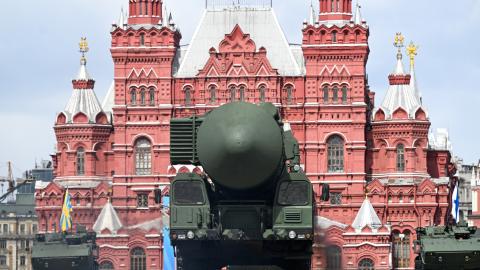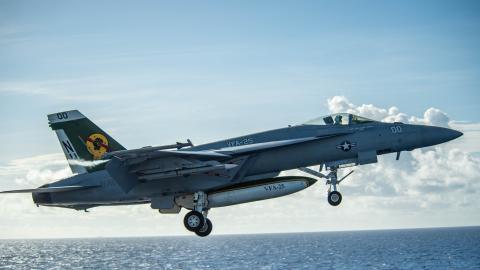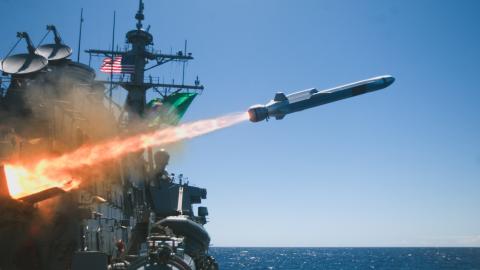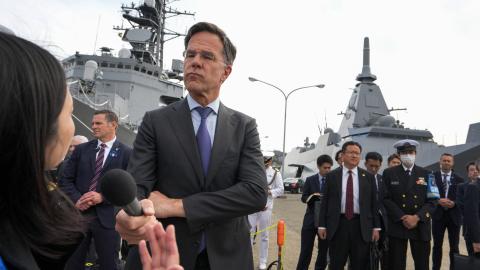INTRODUCTION
The comeback of Mr. Donald Trump as President of the United States is not just the return of the America First Policy, but rather, a revolution in world politics. For many years, allies depended on U.S. leadership while the US led the world without explicitly questioning the necessary cost of global leadership. Now, President Trump demands U.S. allies bear some burden and cost for those alliances. This situation gives a new challenge for U.S. allies around the world, but it could also provide great opportunities for U.S. allies to review its roles in, and commitment to, their alliance with the U.S. The issues touched on in Trump’s inaugural address are mostly domestic ones, with the only foreign countries mentioned being Mexico, Panama and China. This seems a departure from the long-standing U.S. foreign policy of maintaining world order and spreading democracy around the world, thus benefiting the long-term national interests of the U.S. On the other hand, the end of the U.S. role as the world’s policeman was already evident during the Obama administration. Minimal involvement in, and withdrawal from global conflicts has been a constant trend since the early 21st century. U.S.’s allies were aloof from such changes in the American sentiment.
Against this backdrop, this article examines the challenges for U.S. allies such as NATO and Japan and how they should collectively respond to the new US approach to alliance management.
THE CHANGING NATURE OF WORLD ORDER AND EURO-ASIAN SECURITY
The post-World War Two (WWII) world order was based on the premise that five permanent members of the United Nations Security Council would cooperate to maintain peace and stability of the world even though doing so could diminish national interests of those countries. That foundation was shattered when permanent members of the UN Security Council started to harass and coerce their neighbors. The People’s Republic of China (PRC) continues illegal occupation and construct of military bases on the disputed shoals and rocks in the South China Sea and repeated harassment to the Philippine coast guard in the South China Sea. Most recently, Russia occupied and annexed the Crimea Peninsula in 2014 and invaded the eastern flank of Ukraine in February 2022 and continue fighting there. This tectonic shift of world order was also accompanied by the awkward withdrawal of U.S. forces from Afghanistan in August 2021.
The fiasco in the U.S. withdrawal from Afghanistan was not only a tactical failure to protect the Kabul airport but an incident caused by a broader geopolitical misreading of Afghan politics. Supporting the fragile regime without popular support was an extremely difficult endeavor.
"For too long, NATO and other alliances have been heavily dependent on U.S. leadership and resources.”
The way the U.S. committed its resources for the ongoing war in Ukraine has shown a clearly different approach from the global war on terror that started in 2001. Although the decision to invade Ukraine may have been Putin’s own decision, the agreement of “no limit” cooperation between China and Russia two weeks before the invasion, and North Korea’s provision of arms and ammunition to the Russian military and subsequent deployment of North Korea’s brigade-sized military forces to the Kursk region soon after signing of the Comprehensive Strategy Partnership Treaty in June 2024 should have been well prepared in a changing world environment.
The deepening strategic relationship between Russia and North Korea shows the security situation in the Euro-Atlantic theatre was inseparable. Russian challenge to the eastern flank of Europe where NATO is responsible and the Russian support to the North Korea, which threaten the Far East, demonstrates a combined threat. This explains the recently accelerated NATO’s more active engagement with 4 countries in the IndoPacific: Australia, Japan, New Zealand, and the Republic of Korea (IP4 countries).
TRANSFORMATION OF JAPAN’S DEFENSE POLICY IN THE 21ST CENTURY
The Post-WWII Japanese defense policy has limited military engagement in the areas far from Japan. During the Cold War period, Japan’s involvement in international security was mainly through the security cooperation with the United States based on its homeland and naval and intelligence cooperation against the Soviet Union. However, the end of the Cold War pushed Japan to expand its security cooperation into a more active role, such as sending mine-sweepers to the Persian Gulf, and sending peacekeeping forces to Cambodia in the early 1990s.
Later in the decade, North Korean development of nuclear weapons and launching long-range ballistic missiles changed the Japanese defense policy again to a higher level. North Korean spy vessels entered Japanese waters off Noto Peninsula, and they launched Teapodong-1, and intermediate range ballistic missile. Both encroachments shifted Japanese psyche to defense.
The Global War on terror that started after the 9.11 attack on the United States in 2001 further shift Japanese defense policy to send its forces near combat areas. The Constitutional constraints on legislation on the Self-Defense forces for overseas missions were gradually removed by “temporary” and “special measures” legislation with political leadership at the time in the context of the U.S.- Japan alliance.
In response to growing Chinese military capabilities and activities in the East and South China Seas, Japanese security policy advanced. The government established a national security council, drafted a national security strategy in 2013, and passed the peace and security legislation in 2016 that enabled the government to exercise right of collective self-defense that had been long refrained from with the re-interpretation of Article 9 of the Constitution (the renounced war capabilities).
Japan even developed a new security concept coined “Free and Open Indo-Pacific (FOIP)” and accelerated cooperation with broader regional countries that span from East Asia to the east coast of Africa. In particular, Japan tried to strengthen security cooperation with India. The establishment of the Quad framework with India, Australia and the U.S. is a major achievement of this concept.
Most recently, Japan has enhanced defense cooperation with regional countries such as Australia and the Philippines. In addition to more frequent joint training, the signing of the reciprocal access agreements (RAAs), Acquisition and CrossServices Agreements (ACSAs) and the Defense Equipment Technology Transfer Agreement laid a foundation for more effective joint operations, combined logistics of their armed forces and defense industrial cooperation.
"The way the U.S. committed its resources for the ongoing war in Ukraine has shown a clearly different approach from the global war on terror that started in 2001.”
In late 2022, Japan adopted a new National Security Strategy, a National Defense Strategy and a Defense Buildup Plan (collectively referred to as the 3 Strategic Documents). Subsequently, the Japanese government decided to possess counterstrike capabilities, double its defense budget to 2% of its GDP, and build up comprehensive national power that includes a robust defense industrial base.
In addition to joint deterrence and response by the U.S.-Japan alliance, the 3 Strategic Documents emphasized the importance of collaboration with like-minded countries. They stipulated Japan’s determination to strengthen relations with NATO and jointly develop the next generation of fighter aircraft with two NATO members, the United Kingdom and Italy.
In the past decade, the rapid development of Japan’s relations with NATO has been noteworthy given its insular nature of defense relations in Japan. Starting with the conclusion of the Information Protection Agreement in 2010, Japan first participated in NATO’s crisis management exercise in 2014, and later NATO’s cyber exercise, and the sending of personnel to the NATO cyber defense center of excellence in Tallinn, Estonia.1
1 Japan has upgraded its diplomatic function for NATO rapidly.2 In 2014, the Japanese Ambassador to Belgium was appointed as the permanent representative to NATO and established an independent permanent mission in January 2025.3
3 These enhanced relationship with NATO has been built upon the gradual evolution of Japanese security policy in the last 3 decades since the widening and deepening of security concept and the people’s realization of security challenges are crucial to promote military cooperation with NATO countries.
THE NEED FOR ENHANCED COOPERATION AMONG NATO AND U.S. ALLIES IN ASIA
For too long, NATO and other alliances have been heavily dependent on U.S. leadership and resources. This may be natural due to the much greater scale of national power in the U.S. However, there has been too little emphasis on allies and partners playing a greater role in the partnership and allocating resources. The U.S.’s allies should have paid more serious attention to President Trump’s argument for greater contribution from its allies.
Slowly rectifying such flaws, U.S. allies have started to strengthen their own efforts in recent years. Several NATO countries such as Lithuania4, Poland and Germany have raised their defense budget to as much as 3 to 5 percent of their GDP in response to evolving security challenges.5
In the Indo-Pacific region, a collective security system like NATO does not exist. Likely because the security challenges facing Asian countries are so diverse and the threat perception each country had was different. Therefore, a network of bilateral alliances with the U.S. has played a major role to bridge the gap between U.S.-Asian alliances.
For example, in Northeast Asia, various trilateral summit meetings and multinational joint exercises increased. The U.S. has played an important role to bridge gaps between different allies such as Japan and Korea that have difficult issues in history and territory.
If U.S. leadership fails to unite an Asian-American alliance, then the Asian coalition must work together to fill the gap themselves. In addition to regional efforts in Asia, distant powers such as NATO could provide opportunities to cooperate, as they have done with several non-member states before. For instance, NATO and Japan signed the Individually Tailored Partnership Program (ITPP) in 2023. The ITTP was an upgraded agreement of the previous IPCP (Individual Partnership and Cooperation Programme) between NATO and Japan.6 At the same time, Australia, New Zealand and South Korea have also signed a new ITTP to establish a more standardized and integrated cooperation with NATO.7
INTEROPERABILITY, TECHNOLOGY AND INDUSTRIAL COOPERATION
Despite the above-mentioned limit of their relationship, NATO and the IP4 can get mutual benefits by strengthening security cooperation in capacity building, interoperability, defense industrial production, and technology as they lack a common security threat to fight together and can complement each other in many areas.
For instance, NATO has established Centers of Excellence (COEs) in important security areas such as cyber defense, space, counterintelligence, and strategic communications. These are the capabilities IP4 countries such as Japan desperately want to develop in the new security skills.
However, each IP4 has challenges to advance such cooperation. In Japan’s case, long-standing pacifism after WWII lingers in the public’s sentiment which inhibits the government from passing legislation on defense. Further, the legal and political structure sometimes blocks rapid development of military capability and military cooperation with other countries. Japan’s relatively weak security clearance system sometimes makes allies hesitate full-fledged cooperation with the Japanese government.
Japan declared in its 2022 strategy that the security of Europe and Asia is indivisible, and that the security condition of the world is the severest since the end of WWII. However, it is unlikely to envisage their combat forces fighting shoulderto-shoulder for each other’s defense. Their relationship is essentially a security cooperation.
Defense industrial cooperation is another important evolution of new strategic relationships among U.S. allies. Japan decided to develop a next generation fighter with Italy and the United Kingdom. The Global Combat Air Program (GCAP) can be a new venue for strategic industrial cooperation with other U.S. allies as well. Without robust industrial bases, it would be impossible to have strong deterrence against foes.
"The U.S.’s allies should have paid more serious attention to President Trump’s argument for greater contribution from its allies.”
Given the transactional nature of the new administration in the United States, robust collaboration among allies is essential to persuade the U.S. to commit to global affairs. Such strong security cooperation among U.S. allies would also benefit U.S. security interests. The United States could efficiently and effectively maintain and improve its global deployment capabilities and influence with more enhanced allied support.
On the other hand, dialogue with authoritarian regimes such as Russia, China and North Korea should not be neglected. None of these countries are warmongers. We need to understand their security concerns and find a compromise for our mutual security benefits.
For example, unless the Russians feel more secure, they have no reason to stop war and cede occupied territories to Ukraine. We need to find out what NATO can do to remove or relieve Russian anxieties. The North Koreans also need security guarantees to abandon its weapons of mass destruction and stop military provocation to its neighbors. No country including the United States has enough resources to defeat all these revisionist states. Achieving strategic stability without fighting is the best for world peace and development.
CONCLUSION
In a world where global stabilizers and international cooperation is desperately needed, the very function of the UN has frozen. We need to find ways to reconfigure the world order and uphold the equilibrium to avoid falling into Thomas Hobbes’ “war of all against all.”
Therefore, the effort of strengthening capabilities of U.S. allies has become more important than ever to sustain collective defense mechanisms. The new release by the European Commission of the Rearm Europe Plan/Readiness 2030, in March of this year is a positive development of regional security efforts to hedge against the U.S.’s reluctant commitment.
The more robust linkage between NATO and other U.S. allies in this decade is creating new opportunities as well.
The enhanced cooperation and joint capability building between NATO and Japan in key areas such as cyber defense, space operations, and defense industry is essential to uphold international peace and stability in the absence of the UN security function.
The Trump administration should take advantage of advanced allied capabilities and respect their proactive roles in the alliances as it would be effective to maintain U.S. global influence and protect U.S. interests.
















